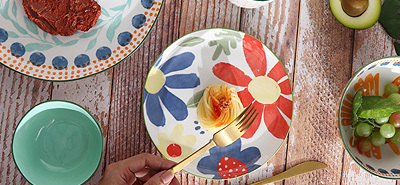Choosing ceramic tableware can be done through four options: "see", "listen", "compare", and "try"
Release time:
2023-05-26
Choosing ceramic tableware can be done through four methods: "see", "listen", "compare", and "try". The detailed methods are as follows:
Choosing ceramic tableware can be done through four methods: "see", "listen", "compare", and "try". The detailed methods are as follows:
1. "Look" means carefully observing the porcelain from top to bottom, inside and outside. Check if the glaze of the porcelain is bright and smooth, without scratches, small holes, black spots, and bubbles; Secondly, check if the shape is regular and deformed; Third, there is no damage on the surface; Fourth, check if the bottom is flat and place it smoothly without burrs.
2. "Listening" is the sound made by gently tapping on porcelain. If the sound is loud and pleasant, it indicates that the porcelain body is detailed, dense, and free from cracks. When fired at high temperatures, the porcelain is thoroughly melted and the quality is relatively good.
3. "Compare" means to compare. For matching porcelain, it is necessary to compare the various accessories simultaneously to see if their shape and surface color tone are coordinated and consistent. In particular, a complete set of blue and white porcelain or small blue and white porcelain, because the color of the blue and white porcelain will change with the firing temperature, so even if it is the same Blue and white porcelain, the color can vary from dark to light. If a set of several or even dozens of pieces of complete cold porcelain has obvious differences in the color of each piece of blue and white porcelain, the appearance of this set of porcelain will be greatly reduced.
4. "Trial" refers to cover testing, assembly testing, and experimentation. Some porcelain comes with a lid, while others are made up of several components. Therefore, when selecting porcelain, do not forget to try to cover the lid and assemble the components to see if they can match each other.
Contact us
Tel:86-0755-25168616
E-mail:jh806@peacehome.com.cn
Web:http://www.szpeacehome.com
Add:Room 1501, Guowei business building, no.68 guowei road, luohu district, Shenzhen Guangdong China

Mobile client





